
All of us goats and some of the sheep got pedicures this weekend. Even me! Mom and Dad hate trimming my hooves while I’m in rut because when I’m feeling frisky I pee on people I like. Mom and Dad wear their oldest clothes when they trim my hooves. I can’t imagine why.
Trimming goat and sheep hooves is easy, but it takes some know-how, too. You need the right tools to do a good job. Dad experimented with a lot of tools, like the expensive hoof-rot trimming shears in the picture below, but he always comes back to classic orange- or green-handled hoof trimmers designed for sheep and goats. He also likes the hand-size hoof plane shown in the picture, but a small, wooden plane works, too.
If you have a fitting or milking stand, place the sheep or goat on it. If you don’t, use a collar and lead or a non-slip neck rope to tie your subject to a sturdy fence. Don’t leave the lead so long that the sheep or goat can rush forward or yank back. About 12 to 14 inches slack works well for a full-sized sheep or goat.Before hoof trimming, gather your tools and secure your sheep or goat. Some people tip sheep on their butts and trim their hooves while they’re sitting up, as though they’re going to be shorn. Mom and Dad have bad backs, so they trim our sheep’s hooves while they’re standing up.
Crowd the sheep or goat against the fence to help secure it, and then pick up a front hoof. If the sheep or goat tries to pull it away, be patient. It’s scary (and annoying) to stand on three legs.
When the hoof is clean, begin trimming any hoof wall that curls under the hoof, snip ragged bits between the claws, then nip off any excess toe. If you trim hooves often, say every month or two, this is probably all you’ll have to do. Sometimes you’ll need to pare the heel or sole. (That’s the part between the walls of a hoof.) If you do, remove material in tiny snips until you see pink, then stop or you’ll make the hoof bleed.Use the tip of your hoof trimmers to clean mud and muck out of the hoof. Some people use a horse hoof pick to do this job.
Then use the hoof or wood plane to clean up and further level the hoof. This step is optional, but it makes a hoof look nice. Goats’ dew claws sometimes need trimming, too. Again, make tiny snips because the hoof will bleed if you take too much. Now go on around the sheep or goat and trim the other hooves. Done! Check out the difference in a clean hoof:

If you’re used to trimming goat hooves and you have to trim a sheep’s, be much more judicious when trimming the sole. Sheep have thinner soles than goats, and it’s easier to over-trim and make them bleed. A good thing about sheep is that their hooves grow more slowly than goats’ hooves, so you don’t have to trim them quite as often.Over the years Mom and Dad have learned a thing or two about trimming hooves. Here are some helpful hints they’d like to share.
- If you’re right-handed, always wear a thick leather glove on your left hand and vice versa. It’s very easy to slip and drive the tip of your shears into your hoof-holding hand, especially if the sheep or goat jumps around. Mom once poked a really deep hole in her left hand and the goat was standing still!
- Dry weather equates with very, very hard hooves. Time pedicures for a few hours to a few days after a rain. You’ll be glad you did.
- Some animals’ hooves grow much faster than others, so schedule trimming sessions to accommodate the fastest growing feet. Expect to trim sheep hooves every few months and goat hooves at six- to eight-week intervals. High-protein, high-energy diets cause hooves to grow more quickly, so if you feed alfalfa hay or high-protein grain, you might have to trim more often.
It’s not much fun for us animals to have our hooves trimmed, but it’s important. If our hooves grow too long it’s hard to walk and young animals’ legs may grow crooked to compensate for bad feet. Old animals with overgrown hooves are more likely to develop arthritis and animals of any age are more susceptible to joint and tendon problems. So trim your sheep’s and goats’ feet! We need it—even us pee-shooting bucks. Ha!




